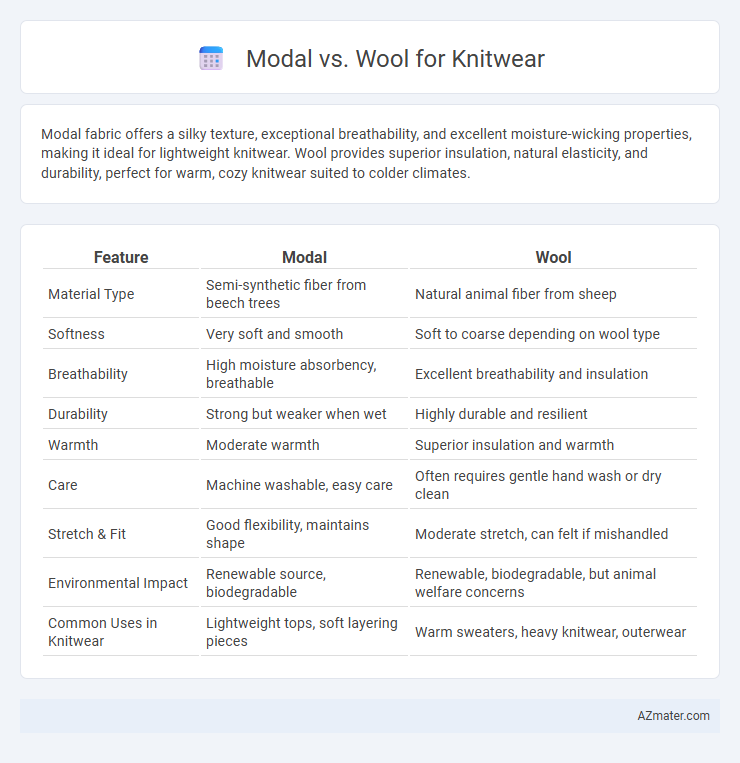Modal fabric offers a silky texture, exceptional breathability, and excellent moisture-wicking properties, making it ideal for lightweight knitwear. Wool provides superior insulation, natural elasticity, and durability, perfect for warm, cozy knitwear suited to colder climates.
Table of Comparison
| Feature | Modal | Wool |
|---|---|---|
| Material Type | Semi-synthetic fiber from beech trees | Natural animal fiber from sheep |
| Softness | Very soft and smooth | Soft to coarse depending on wool type |
| Breathability | High moisture absorbency, breathable | Excellent breathability and insulation |
| Durability | Strong but weaker when wet | Highly durable and resilient |
| Warmth | Moderate warmth | Superior insulation and warmth |
| Care | Machine washable, easy care | Often requires gentle hand wash or dry clean |
| Stretch & Fit | Good flexibility, maintains shape | Moderate stretch, can felt if mishandled |
| Environmental Impact | Renewable source, biodegradable | Renewable, biodegradable, but animal welfare concerns |
| Common Uses in Knitwear | Lightweight tops, soft layering pieces | Warm sweaters, heavy knitwear, outerwear |
Introduction to Modal and Wool in Knitwear
Modal, a semi-synthetic fiber derived from beech tree pulp, offers exceptional softness, breathability, and moisture-wicking properties that make it ideal for lightweight knitwear. Wool, a natural fiber obtained from sheep, provides excellent insulation, durability, and wrinkle resistance, commonly used in knitwear for warmth and structure. Both fibers contribute distinct benefits to knitwear, with Modal favored for comfort and drape, while Wool excels in thermal regulation and resilience.
Origin and Production Processes
Modal is a semi-synthetic fiber derived from beech tree pulp primarily produced through a chemical-intensive spinning process that enhances its softness and durability. Wool, sourced from the fleece of sheep through shearing, undergoes natural cleaning and carding techniques followed by spinning to create yarns with excellent warmth and elasticity. Modal production heavily relies on sustainable forestry practices in regions like Central Europe, while wool production is rooted in traditional livestock farming across countries such as Australia and New Zealand.
Texture and Feel: Comparing Modal and Wool
Modal knitwear offers a smooth, silky texture that feels exceptionally soft and lightweight against the skin, making it ideal for sensitive skin and warm climates. Wool, particularly merino wool, provides a natural, slightly coarse texture that delivers excellent insulation and moisture-wicking properties, creating a cozy yet breathable feel. While modal excels in drape and softness, wool stands out for durability and temperature regulation in knitwear.
Breathability and Moisture Management
Modal fibers offer superior breathability compared to wool, allowing air to circulate more freely and keeping the wearer cooler in warmer conditions. Wool naturally excels at moisture management by wicking sweat away from the skin and retaining warmth even when damp, making it ideal for cold and variable climates. Both fibers provide strong moisture control, but Modal's lightweight texture enhances ventilation, while wool's insulation properties maintain comfort in diverse weather.
Warmth and Insulation Properties
Modal fabric offers moderate warmth with excellent breathability and moisture-wicking abilities, making it suitable for lightweight knitwear in mild climates. Wool excels in insulation due to its natural crimp and lanolin content, effectively trapping heat and providing superior warmth even when damp. For knitwear prioritizing heat retention and insulation in colder conditions, wool remains the preferred choice over modal.
Durability and Longevity
Modal knitwear offers superior durability due to its high resistance to shrinkage and pilling, making it ideal for long-lasting garments. Wool, while naturally resilient and excellent in retaining shape, may experience wear faster when subjected to frequent washing and abrasion. Choosing modal enhances longevity through its stable fiber structure, whereas wool requires careful maintenance to preserve its durability over time.
Eco-Friendliness and Sustainability
Modal fiber, derived from beech trees, is highly eco-friendly due to its biodegradable nature and low water consumption during production, making it a sustainable choice for knitwear. Wool, sourced from sheep, offers natural biodegradability and excellent insulation properties, but its environmental impact varies with farming practices and land use. Choosing knitwear crafted from responsibly produced modal or ethically sourced wool supports sustainable fashion and reduces the carbon footprint of clothing.
Comfort for Sensitive Skin
Modal fabric offers superior softness and breathability, making it ideal for sensitive skin due to its smooth, non-irritating texture. Wool, while naturally insulating and moisture-wicking, can sometimes cause itchiness or irritation for delicate skin types. Choosing Modal knitwear provides enhanced comfort by reducing friction and maintaining gentle temperature regulation.
Care and Maintenance Requirements
Modal knitwear requires gentle care, typically hand washing or machine washing on a delicate cycle with cold water to preserve its softness and prevent shrinking. Wool knitwear demands more careful maintenance, including hand washing in lukewarm water or dry cleaning, and avoiding high heat drying to prevent felting and shrinking. Both fabrics benefit from flat drying and storing in a breathable bag to maintain shape and longevity.
Choosing Between Modal and Wool for Knitwear
Modal knitwear offers superior softness, moisture-wicking properties, and breathability, making it ideal for sensitive skin and warmer climates. Wool knitwear provides excellent insulation, durability, and natural odor resistance, suited for cold-weather garments requiring warmth and resilience. When choosing between modal and wool for knitwear, consider the climate and intended use, prioritizing modal for lightweight comfort and wool for thermal protection.

Infographic: Modal vs Wool for Knitwear
 azmater.com
azmater.com